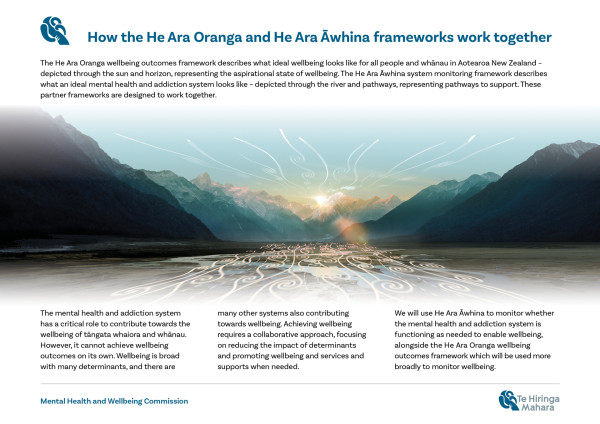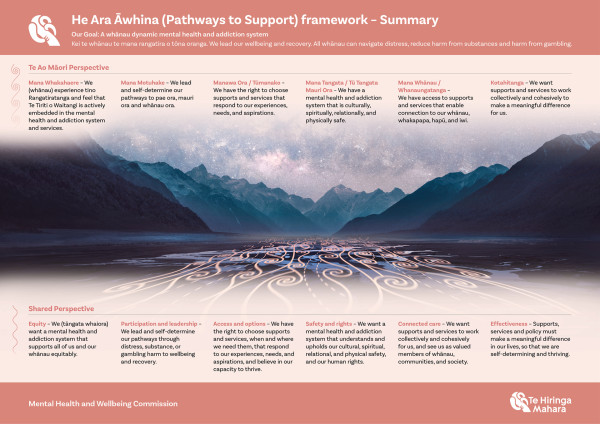He Ara Āwhina te tarāwaho He Ara Āwhina Framework
We created a framework called He Ara Āwhina, which means pathways to support. He Ara Āwhina was published 30 June 2022 and describes what an ideal mental health and addiction system looks like. This will be used to assess, monitor, and advocate for improvements to the mental health and addiction system of Aotearoa, including services.
He Ara Āwhina amplifies the most important voices – tāngata whaiora and whānau as leaders of their wellbeing and recovery, and the system responding to their needs and aspirations. What people told us in our 2022 He Ara Āwhina framework consultation, and the changes made in response, have been summarised in four ‘voices documents’ showing feedback from Māori, people with Lived Experience, and the Shared perspective.
Read and download our He Ara Āwhina (pathways to support) framework [PDF 3.1 MB]
Our Goal: a whānau dynamic mental health and addiction system
He Ara Āwhina has a goal of a whānau-dynamic mental health and addiction system, which means to realise the potential of whānau. We have published two versions of the framework – a summary version that is focused on the system aspirations, and the full framework that includes detailed descriptions of what an ideal mental health and addiction system looks like.
Te Hiringa Mahara will use He Ara Āwhina to monitor services and assess whether the mental health and addiction system is functioning as needed to enable wellbeing alongside the He Ara Oranga wellbeing outcomes framework, which will be used more broadly to monitor wellbeing. These partner frameworks are designed to work together.
Read and download How the He Ara Oranga and He Ara Āwhina frameworks work together [PDF 2.3 MB]
Two perspectives and the system aspirations
There are two perspectives in He Ara Āwhina that describe what an ideal mental health and addiction system looks like:
Te Ao Māori perspective, which was developed by Māori, with Māori, for Māori:
- Mana Whakahaere
- Mana Motuhake
- Manawa Ora / Tūmanako
- Mana Tangata / Tū Tangata Mauri Ora
- Mana Whānau / Whanaungatanga
- Kotahitanga
Shared perspective, which is for everyone:
- Equity
- Participation and leadership
- Access and options
- Safety and rights
- Connected care
- Effectiveness
These two perspectives work together, for instance, the shared perspective also applies to Māori. They are not direct translations of each other, but weave together reflecting the role that Tangata Whenua and Tangata Tiriti have to play – working together to support improving the collective wellbeing of all.
Each perspective of He Ara Āwhina has six system aspirations that describe what good looks like for tāngata whaiora and whānau from their voices. These aspirations represent the important issues raised by communities during the mental health and addiction inquiry as well as our development and engagement processes.
An Expert Advisory Group (EAG) of external contributors provided oversight and advice throughout the development of He Ara Āwhina.
We are currently in the important stage of the mahi (work) to develop the methods and measures for how we will monitor and assess the mental health and addiction system.
We have established a Technical Advisory Network (TAN) to provide advice and expertise of methods, measures, data sources and data gaps.
-
He Ara Awhina Framework
Read and download our He Ara Awhina Framework.
- Report
-
Co-development phase - public consultation feedback
Read more about our He Ara Āwhina co-development phase.
- Report
-
He Ara Āwhina development journey
Read more about our He Ara Āwhina development journey. This covers the co-define phase beginning in October 2020, the co-development phase, and the methods and measurement phase.
-
Guide to language in He Ara Āwhina
Read more about our guide to language in He Ara Āwhina.

